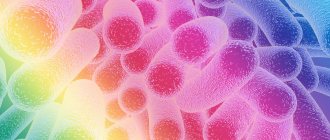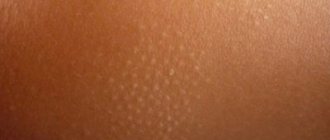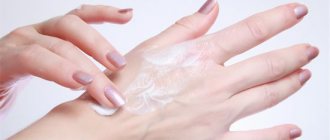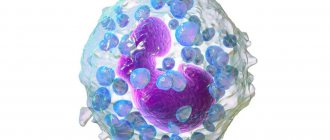Our skin is constantly in contact with a large number of allergens, so skin allergies are one of the most common types.
A group of diseases in which the main symptoms are skin allergies are called allergic dermatoses. These include diseases such as urticaria, allergic contact dermatitis, atopic dermatitis, eczema, toxicerma, etc.
Skin allergies: main causes
There are many reasons for the development of allergic dermatosis: various food allergens, medications, household chemicals, cosmetics, etc.
Skin allergies are caused by:
- Living in regions with unfavorable ecology.
- The presence of occupational hazards (prolonged human contact with aggressive objects: alkalis, acids, smoke, medications, etc.).
- Eating with a large number of allergenic foods.
- High drug load.
- Widespread use of household chemicals containing highly allergenic chemical compounds, dyes and fragrances.
- In young children, skin allergies can be triggered by early cessation of breastfeeding and early introduction of complementary foods.
Risk factors also include a hereditary predisposition to allergic diseases.
In addition, the causes of exacerbation of skin allergies can be diseases of the gastrointestinal tract, stress, etc.
Rashes due to liver diseases
In the early stages of liver disease, they practically do not manifest themselves at all. The earliest symptom is specific skin rashes. They are caused by an increase in the amount of bile acid in the blood, which causes general intoxication of the body. The skin takes on a yellowish tint.
With cholestasis (blockage of the bile ducts), the rash is localized on the feet and palms, looking like marks from a burn. With cirrhosis, liver cells die and the whole body becomes covered with spots. Parasitic liver diseases cause rashes resembling hives. They are localized in the lumbar region and abdomen.
Also characteristic is a combination of rash and spider veins, which cause severe itching, which intensifies at night. Taking antihistamines (allergy medications) does not provide relief. Increased bilirubin gives the skin a yellowish tint.
Skin allergies: symptoms
Symptoms of skin allergies may appear immediately after contact with the allergen or after some time (from 10-20 minutes to 1-2 days).
The main signs of skin allergies can be considered:
- rash (can vary significantly with different types of skin allergies);
- redness and swelling of the skin;
- itching, scratching;
- dryness and flaking of the skin.
Scratching may lead to a bacterial or fungal infection, which further aggravates the course of the disease. All this creates severe physical and psychological discomfort, disrupting sleep and affecting ability to work.
Depending on the type of allergic dermatosis, certain signs of skin allergies may be particularly pronounced or, conversely, absent.
Rash caused by digestive problems
The condition of the skin largely depends on the functioning of the internal organs. Using a map of rashes on the face, you can determine which organs have problems.
- pimples on the forehead indicate problems with the intestines;
- a rash along the hairline indicates problems with the gallbladder;
- pimples on the bridge of the nose - liver problems;
- ulcers on the temples - problems with the spleen;
- rashes above the lip - disruption of intestinal function;
- pimples on the nose - heart disease or endocrine disorders;
- rash on the chin - gynecological problems.
Brief characteristics of the most common types of skin allergies
Hives
The term “urticaria” unites a whole group of diseases of different nature, but with a similar clinical symptom - blistering-type skin rashes, reminiscent of a nettle burn.
The causes of urticaria are varied. Skin allergies can develop as a result of a reaction to allergens (eg, food, insect bites, medications) or from physical causes such as exposure to the sun, cold, heat and pressure. Hives can be triggered by concomitant diseases of the gastrointestinal tract, endocrine system, or chronic infection.
A typical symptom of urticaria is the appearance of rashes on the skin accompanied by itching. The skin around them may be red. Sometimes all the elements on the affected area of the skin can merge together, forming giant blisters.
The main characteristic of skin allergies is the complete reversibility of blisters: after some time they disappear without a trace, leaving no traces, white spots or scars. But unlike a regular nettle burn, this disease appears again, and with a change in location: today the urticaria was on the legs, and tomorrow it can be found on the arms.
Allergic contact dermatitis
Allergic contact dermatitis is a skin allergy caused by direct exposure to an irritating substance, or allergen.
Most often, contact dermatitis is caused by household chemicals, cosmetics, various chemicals, nickel, latex, and some medications.
Allergic contact dermatitis develops on areas of the skin that have been or are in contact with an allergen.
The first symptoms and signs of contact dermatitis may not develop immediately, but some time after contact with the allergen - several hours, days or even weeks.
The main manifestations of allergic contact dermatitis: redness and swelling of a limited area of the skin that has been in contact with the allergen, severe itching in the area of redness, and the appearance of blisters of various sizes on the skin with a clear liquid inside. When damaged, the bubble bursts and erosion forms in its place. When the skin allergy subsides, yellow crusts remain for some time.
Atopic dermatitis
Atopic dermatitis is a chronic allergic skin disease accompanied by itching and rash. This skin allergy is common in infants and children and usually begins in the first 6 months of life, often continuing into adulthood.
Atopic dermatitis is a multifactorial disease. The leading factor is hereditary predisposition. Food and inhalant allergens play an important role. In childhood, the main food allergens are milk proteins, chicken eggs, fish, and grains. With age, inhalation allergens are added: house dust, animal hair, plant pollen.
Provoking factors for atopic dermatitis can be mechanical, physical or chemical irritants, increased sweating, tobacco smoke, stress, hormonal factors, and infection.
Atopic dermatitis has three sequential forms (infantile, childhood and adult dermatitis), differing in the characteristics of their manifestation.
Any form of atopic dermatitis is characterized by dry skin, itching, thickening of the skin with increased skin pattern, peeling, redness and rashes.
With atopic dermatitis, a vicious circle is formed: itching - scratching - rash - itching. The skin with atopic dermatitis is changed even without an exacerbation. Its structure and water balance are disturbed.
Eczema
Eczema is a chronic recurrent skin disease of allergic origin, characterized by a polymorphic itchy rash (vesicles, erythema, papules). The causes of eczema can be very different, from external factors (chemicals, drugs, food and bacterial allergens) to internal ones.
Exacerbations of this type of skin allergy occur under the influence of psycho-emotional stress, diet disorders, contact with chemicals and other allergens.
Depending on the cause of the appearance and location of the rash, several types of eczema are distinguished: seborrheic, true, occupational, microbial. The areas where the rash is localized tend to itch and peel, causing a lot of inconvenience to the person. Eczema is chronic with periods of exacerbations and remissions, and treatment of skin allergies is often complicated by the addition of pyoderma or herpes. With skin allergies of this type, changes in the functional activity of the digestive tract, metabolic processes, neuroendocrine disorders, and vegetative-vascular dystonia can also be observed.
Toxidermy
Toxidermia is an acute toxic-allergic inflammatory skin lesion, which is an allergic reaction to the introduction into the body (inhalation, ingestion, parenteral administration) of substances with allergenic properties.
The causes of toxicerma are most often drugs and food products.
More often, widespread toxicerma is observed, which is manifested by multiple rashes and itching. Often this type of skin allergy involves the mucous membranes, which may also have various rashes.
In addition to the common one, fixed toxicoderma is possible, in which one or more swollen red spots of round or oval shape appear; in some cases, a bubble may form in the center of each of them. Typically, such skin allergies are associated with taking medications. After the action of the allergen ceases, the inflammatory phenomena subside, and the stain remains for a long time. The most severe forms of toxicerma are Stevens-Johnson syndrome and Lyell's syndrome. They are considered emergencies and require hospitalization.
With a huge variety of allergic dermatoses themselves, there are diseases with similar symptoms. For example, a rash can accompany some infections, diseases of internal organs, etc. Therefore, do not try to diagnose yourself with “skin allergies” and do not self-medicate.
Only a doctor, having collected a detailed history and conducted the necessary examination, will be able to determine the exact cause of the disease and prescribe medications that are suitable in each specific case.
Treatment
Therapeutic treatment methods should be aimed primarily at eliminating pathogenetic factors.
Patients are shown sedatives (especially with intense chronic itching), emollients (to reduce dry skin, which is both a cause and a consequence of itching), topical distraction agents (cold lotions, menthol-containing products, etc.), antihistamines, which In the vast majority of cases, they are first-line drugs.
There are two generations of antihistamines: sedative (Suprastin, Tavegil, Diazolin, Diphenhydramine, Fenkarol, Fenistil) and non-sedating/weak sedative (cetirizine, levocetirizine, loratadine, desloratadine, fexofenadine, ebastine, rupatadine).
It is important to note that, despite the need to take sedatives, it is better not to use first-generation antihistamines (which have a sedative effect in addition to antihistamines). Firstly, sleep when using them is unphysiological (the drugs inhibit the REM sleep phase). Secondly, the multiple side effects characteristic of this group of drugs limit their use in a large group of patients with concomitant diseases. Therefore, it is better to use tranquilizers as sedatives, and when choosing antihistamines, preference should be given to second-generation blockers.
Cetirizine occupies a special place among them.
Rashes due to intestinal diseases
If the contents of the intestines are poorly removed from the body, then some of the toxins will begin to penetrate into the blood. The body begins to get rid of poisons itself through the excretory system. Because of this, the condition of the skin worsens, and it becomes characteristic of:
- increased fat content
- dull complexion
- acne, not only on the face, but also on the back, stomach, chest
- “black dots” are visible, similar to volcanic craters
- skin becomes dry and dehydrated
- After acne heals, scars remain.
After the New Year holidays, many people note a deterioration in their skin condition and notice minor rashes that go away on their own. They are associated with contamination of the body with toxins caused by eating large amounts of heavy food.
Experts' opinion
The conducted clinical study proves the high efficiency, safety and tolerability of products for daily skin care of children with mild and moderate forms of atopic dermatitis and during remission, accompanied by a decrease in the quality of life of patients. As a result of therapy, a decrease in the activity of the inflammatory process, a decrease in dryness, itching and flaking was noted.
Product properties confirmed by clinical research:
In the course of research conducted by the Union of Pediatricians of Russia, it was found that La-Cree cream for sensitive skin:
- reduces itching and irritation;
- relieves skin redness;
- moisturizes and gently cares for the skin.
Based on the results of clinical studies, the product packaging contains information that the creams are recommended by the St. Petersburg branch of the Union of Pediatricians of Russia.
Sources:
- Skin diseases of newborns and infants. Guide for doctors / Gorlanov I. A., Leina L. M., Milyavskaya I. R., Zaslavsky D. V. St. Petersburg: Folio. 2021.-208 p.
- A.N. Pampura, A.A. Chuslyaeva, Modern approaches to the treatment of atopic dermatitis in children https://cyberleninka.ru/article/v/sovremennye-podhody-k-terapii-atopicheskogo-dermatita-u-detey
- Yukhtina N.V., Modern ideas about atopic dermatitis in children https://cyberleninka.ru/article/v/sovremennye-predstavleniya-ob-atopicheskom-dermatite-u-detey
Nervous rash
Stress and nervous tension often cause skin rashes. Under the influence of a stressful situation, the immune system is suppressed. The body spends its resources to maintain the normal state of internal organs. For this reason, previously hidden diseases worsen. Also, weakened immunity provokes urticaria - a small rash similar to the reaction of the epidermis to the touch of nettles. This pathology is otherwise called nervous eczema. It, unlike a normal allergic reaction, is accompanied by the following symptoms:
- severe itching that is not relieved by antihistamines
- pulse quickens, hand tremors are felt
- restless sleep, night sweats
- panic attacks, feelings of anxiety and danger
- swelling of the face and limbs.
Typically, nervous eczema occurs after a traumatic situation or severe stress. Treating skin rashes with creams or medications does not help. Improvement comes only after the life situation normalizes. Itchy urticaria due to nervousness can be soothed by baths with sea salt, which also have a good effect on the nervous system.
Skin rashes due to gynecological problems
The condition of a woman’s reproductive organs is closely dependent on her hormonal levels. Many diseases (uterine fibroids, ovarian cysts, endometriosis) are caused by hormonal imbalance, in particular, the ratio of androgens (male sex hormones) and female sex hormones, which is primarily signaled by a specific rash on the skin. Androgens, particularly testosterone and DHT (dihydrotestosterone), are produced in women by the adrenal glands and testicles. The cells lining the sebaceous glands of the skin have androgen receptors. When the amount of hormones increases, the receptors react and the skin secretes more sebum, creating a nutritional base for bacteria. Moreover, DHT begins to be produced by the adrenal glands even before the onset of puberty, so in adolescents, especially girls, rashes have been observed since the age of 10-12.
When a woman has polycystic ovary syndrome, the amount of female hormones estrogen and progesterone decreases and the level of androgens increases sharply. Along with menstrual irregularities, a woman develops severe “teenage” acne on her face and chest. Darkening of the skin is noticeable in the groin, armpits and around the neck. The woman also notes increased hairiness on her legs, arms, and above her lip. All this is due to hormonal imbalance.
An increase in the level of female hormones also affects the condition of the skin. In addition to acne on the face and body, excess estrogen makes the skin dull and dull. She seems to be losing her tone. There is also a decrease in blood sugar levels and an increase in platelet counts.
The increase in progesterone also does not go away without leaving a trace. The skin has progesterone receptors, which respond to the growth of the hormone by increasing the production of sebum until the appearance of oily seborrhea. The scalp becomes covered with crusts, pink spots appear on the face and body, the skin on which flakes and flakes off. In adolescents, the face becomes covered with bumps, which, when pressed, release a liquid sebaceous secretion.
Babies also experience hormonal rashes, which can be very frightening for a new mother. This is the so-called neonatal cephalic pustulosis. It arises because the baby begins to live separately from the mother’s body, and for him this is a serious hormonal shock. The secretion of the sebaceous glands increases, the ducts become clogged, which creates favorable conditions for the activity of microbes.
Also, the newborn’s body gets rid of the hormones that its mother supplied it with during pregnancy. In addition to skin rashes, girls have swollen breasts and vaginal discharge. In boys, the scrotum and penis swell. All these symptoms go away on their own after a few days. The mother needs to make sure that the baby does not sweat and that bacteria do not multiply on the skin.
If you find an error, please select a piece of text and press Ctrl+Enter
Folliculitis
The cause of inflammation of the hair follicle is bacteria and fungi. Pathogens enter small wounds and microcracks on the skin that appear from friction with clothing, in cases of insufficient personal hygiene, increased sweating, and metabolic disorders.
The onset of the disease is characterized by the appearance of a small red spot on the skin around the hair, which then turns into an abscess. After the abscess opens, a crust appears on the skin. In the absence of treatment, further development of the disease with the formation of a boil or carbuncle is possible.
To treat this disease, local procedures are usually carried out - treating the inflamed element with antimicrobial ointment or antiseptics. In severe cases, systemic use of antibiotics and antifungals.
Skin care products to restore healthy skin
Treatment of a rash cannot be based on the use of care products alone. However, when the healing process begins, it is necessary to provide the skin with sufficient hydration and nutrition. You can do this using La-Cri products.
La-Cri restorative cream is an effective cream for allergic rashes, which also helps in the treatment of other types of skin rashes. This remedy has a restorative, soothing and anti-inflammatory effect. The rash cream contains a number of natural additives - walnut, string, violet and licorice extract, avocado oil, bisabolol, panthenol. These components soothe and soften the skin, promote healing of scratches and cracks caused by itching, and have an antimicrobial effect. Panthenol has a regenerating and cleansing effect, strengthening the natural barrier of the epidermis.











